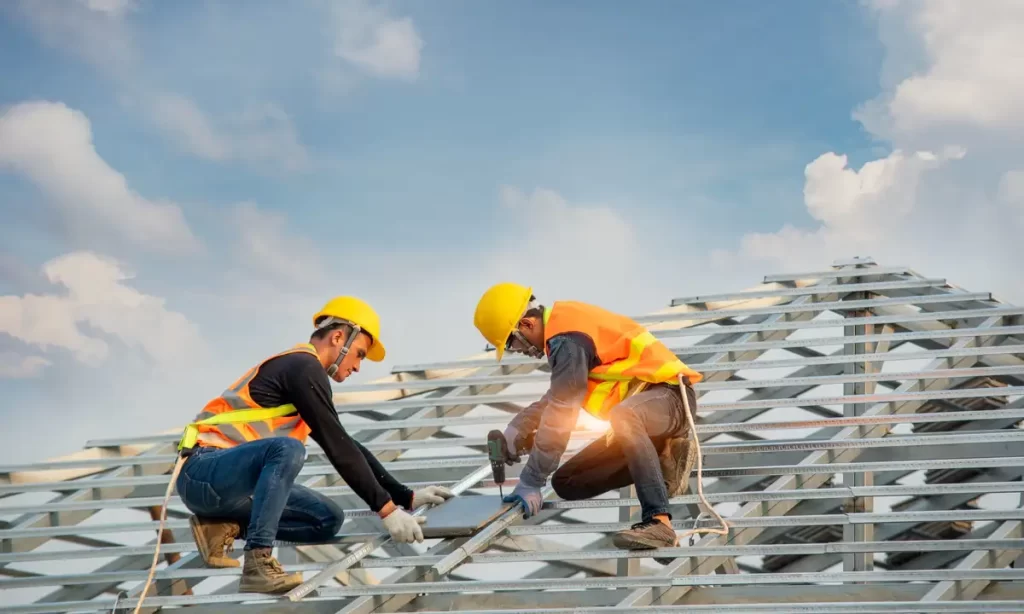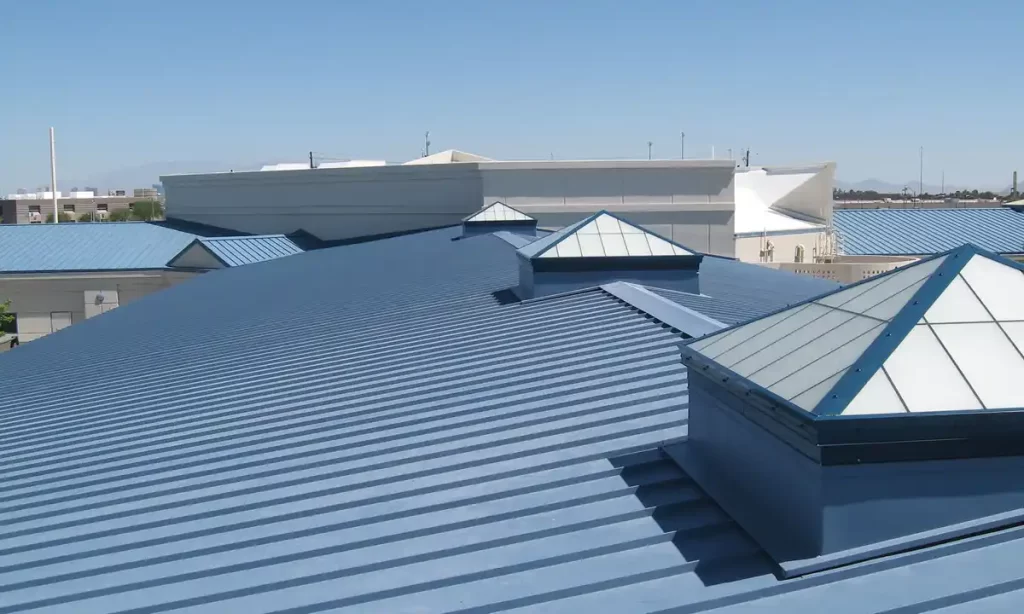When it comes to commercial buildings, the roof is one of the most critical components. A well-designed and properly maintained roofing system is essential for protecting the structure, its contents, and the people inside from the elements. In this comprehensive guide, Authentic Roofling explore and Understanding the life cycle of commercial roofing systems is crucial for building owners, facility managers, and construction professionals to ensure the longevity and performance of these vital assets. A commercial roofing system’s life cycle refers to the stages it goes through, from design and installation to maintenance and eventual replacement. Each stage plays a crucial role in determining the system’s durability, functionality, and cost-effectiveness over time. Let’s explore the various phases of a commercial roofing system’s life cycle in detail.
Design and Specification:
The life cycle of a commercial roofing system begins with the design and specification phase. During this stage, architects, engineers, and roofing professionals collaborate to determine the most suitable roofing materials, configurations, and construction methods for the specific building and climate conditions. Factors such as building usage, local weather patterns, insulation requirements, and energy efficiency goals are taken into account. Thorough planning and specification are essential to ensure a roofing system that meets the building’s needs and provides long-term performance.
Installation:



Once the design and specification are finalized, the installation phase begins. A properly executed installation is critical to the overall performance and longevity of the roofing system. Experienced and skilled roofing contractors follow industry best practices to ensure that the materials are installed correctly, from the roof deck and insulation to the membrane and flashing details. Quality control measures, including regular inspections and adherence to manufacturer guidelines, are crucial during the installation process to prevent future issues and warranty concerns.
Maintenance and Repair:
Regular maintenance and roof inspections are vital and prompt repairs are key to extending the life of a commercial roofing system. Maintenance activities may include routine inspections, cleaning debris and dirt, clearing gutters, and identifying and addressing potential issues early on. Roofing professionals should conduct comprehensive inspections at least twice a year, in the spring and fall, to assess the roof’s condition, identify signs of damage or deterioration, and perform necessary repairs. Timely maintenance and repairs help prevent minor problems from escalating into major issues that could compromise the roof’s integrity and lead to costly repairs or premature replacement.
Roofing System Upgrades:
Over time, commercial buildings may require roofing system upgrades to meet changing needs, code requirements, or technological advancements. Upgrades could involve adding additional insulation, installing a green roof, incorporating solar panels, or implementing new roofing materials for improved energy efficiency or durability. Roofing professionals can assess the existing system, evaluate the building’s requirements, and propose appropriate upgrades to enhance the roof’s performance, extend its life, and reduce long-term operating costs.
Replacement:
Eventually, even a well-maintained and properly repaired commercial roofing system will reach the end of its life cycle. The exact lifespan of a roofing system depends on various factors, including the quality of materials, installation craftsmanship, maintenance practices, and environmental conditions. When signs of significant deterioration, leaks, or repeated repairs become evident, it may be time to consider roof replacement. Engaging a professional roofing contractor to conduct a thorough assessment and provide an accurate evaluation is essential before embarking on a replacement project.
Disposal and Sustainability:
During roof replacement, proper disposal of old roofing materials is crucial for environmental sustainability. Various recycling options exist for commercial roofing materials, including asphalt shingles, metal, and single-ply membranes. Recycling not only reduces waste in landfills but also helps conserve resources and supports sustainable construction practices. Building owners and facility managers should work with reputable roofing contractors who prioritize responsible disposal methods and encourage environmentally friendly practices.
Environmental and External Factors:
The life cycle of a commercial roofing system can be influenced by various environmental and external factors. Climate conditions, such as extreme temperatures, high winds, heavy rain, or snowfall, can accelerate the wear and tear on the roof. Additionally, the presence of nearby trees or vegetation can lead to issues like debris accumulation or the growth of moss and algae, which can impact the roof’s integrity. Regular cleaning and maintenance to mitigate these external factors can help prolong the life of the roofing system.
Energy Efficiency and Sustainability:
In recent years, energy efficiency and sustainability have become crucial considerations for commercial roofing systems. Upgrading to energy-efficient roofing materials, such as cool roofs or green roofs, can not only improve the building’s energy performance but also extend the life cycle of the roof. Cool roofs reflect sunlight and reduce heat absorption, reducing the strain on the HVAC system and improving indoor comfort. Green roofs, on the other hand, provide additional insulation, absorb rainwater, and contribute to environmental sustainability.
Building Code Compliance:



Adhering to building codes and regulations is essential when installing or repairing a commercial roofing system. Building codes often prescribe specific requirements for roof design, materials, and installation methods to ensure the safety and durability of the structure. Compliance with these codes not only ensures the longevity of the roofing system but also helps avoid legal and insurance issues in the future.
Proper Drainage and Gutters:
Proper drainage is a critical factor in the life cycle of a commercial roofing system. A well-designed and maintained drainage system helps prevent water accumulation, which can lead to leaks, ponding, and accelerated deterioration of the roof. Clogged or damaged gutters and downspouts can impede the flow of water, causing backups and potential water damage. Regular inspection and cleaning of gutters and ensuring proper slope and drainage on the roof surface are essential to maintain the longevity of the roofing system. By addressing drainage issues promptly, the risk of water-related damage can be significantly reduced, contributing to a longer life cycle for the commercial roof.
FAQS:
What is the life cycle of a commercial roofing system?
A commercial roofing system’s life cycle refers to the stages it goes through from installation to eventual replacement. This includes initial maintenance, mid-life repairs, considerations for roof replacement, and ongoing maintenance and inspections.
How long does a commercial roofing system typically last?
The lifespan of a commercial roofing system can vary depending on several factors, including the type of roofing material, quality of installation, regular maintenance, and environmental conditions. On average, commercial roofing systems can last anywhere from 20 to 50 years.
What are some common signs that indicate a commercial roof may need repairs or replacement?
Signs that a commercial roof may require repairs or replacement include leaks, visible damage to the roof membrane, water stains on ceilings or walls, excessive wear and tear, frequent repairs, and age. Regular inspections by roofing professionals can help identify these issues early on.
How can I extend the life of my commercial roofing system?
Regular maintenance, including inspections, cleaning, and prompt repairs, is key to extending the life of a commercial roofing system. Additionally, proactive measures such as applying protective coatings, addressing drainage issues, and implementing energy-efficient practices can contribute to a longer life cycle for the roof.
When should I consult with a roofing professional regarding my commercial roofing system?
It is advisable to consult with a roofing professional when facing any concerns or questions regarding your commercial roofing system. This includes issues such as leaks, visible damage, age-related concerns, or when considering repairs or replacements. Roofing professionals can provide expert advice, conduct thorough inspections, and offer appropriate solutions based on your specific needs.
Conclusion:
Understanding the life cycle of commercial roofing systems is crucial for building owners and facility managers to effectively manage and maintain their roofs. From the installation and initial maintenance to mid-life repairs, eventual replacement considerations, and ongoing maintenance, each stage plays a significant role in maximizing the longevity of the roofing system.
Regular inspections by qualified professionals, adherence to building codes, and addressing issues promptly are essential practices in prolonging the life cycle of commercial roofs. Factors such as weathering, aging, manufacturer’s warranties, and budgeting for maintenance and repairs should also be considered.
Additionally, incorporating energy-efficient and sustainable practices, such as cool roofs or green roofs, can enhance the performance and durability of commercial roofing systems. By prioritizing proper drainage and gutter maintenance, the risk of water-related damage can be minimized.
Consulting with roofing professionals throughout the life cycle of a commercial roofing system provides valuable insights and guidance. They can assess the condition of the roof, recommend appropriate maintenance and repair strategies, and determine if and when a roof replacement is necessary.
By understanding and actively managing the life cycle of commercial roofing systems, building owners and facility managers can ensure the long-term protection of their structures, optimize energy efficiency, and minimize potential risks. With proper care and attention, commercial roofs can provide reliable performance for many years, safeguarding the building and its occupants.

